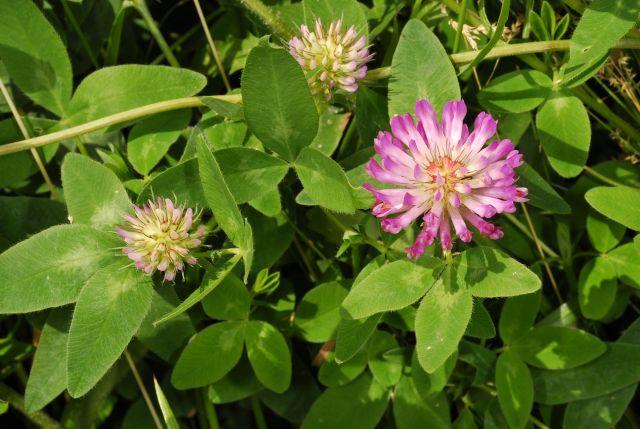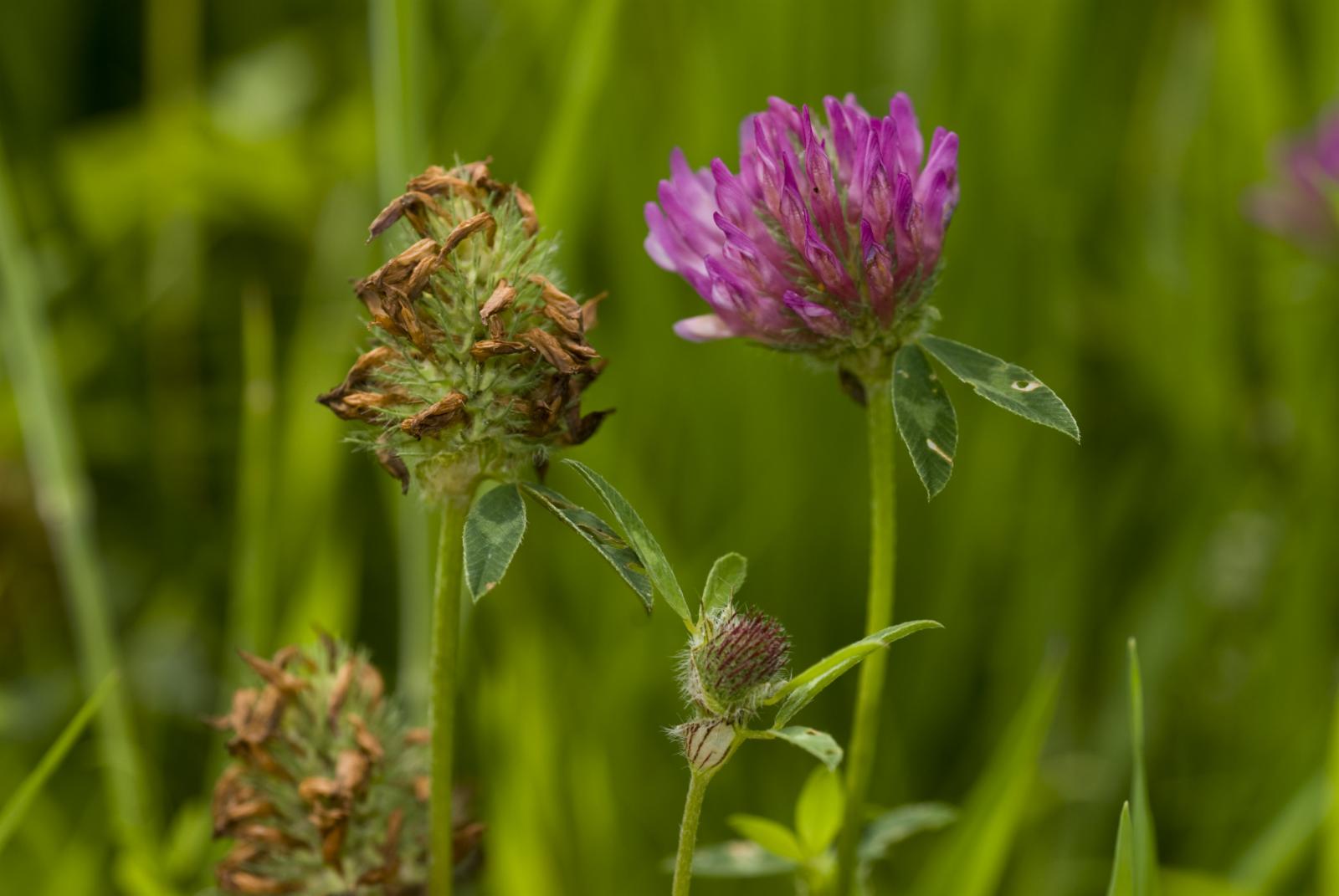Red Clover
trifolium pratense
Also known as: ["Red Clover","Wild Clover","Honey Clover"]
Overview
A perennial herbaceous plant in the legume family, known for its trifoliate leaves and pinkish-red flower heads.
Benefits & Perks
["long-flowering","wildlife attractant (bees, butterflies, birds)","drought tolerant","medicinal use"]
Botanical Classification
| Phylum: | Magnoliophyta |
| Class: | Magnoliopsida |
| Order: | Fabales |
| Family: | Fabaceae |
| Genus: | Trifolium |
| Botanical Name: | Trifolium pratense |
Plant Characteristics
Basic Information
- Category: Flowers
- Suitable Location: garden bed or meadow, prefers open spaces
- Suitable For:
- Is Weed: No
- Allergenicity: low
Environmental Needs
- Climate: {"temperatureRange":"5–30°C"}
- Hardiness: {"zones":"3–8"}
- Misting: rarely required, only if ambient humidity is very low
- Drainage: Moderate to well-draining.
- Soil Type: Rich, loamy soil with good organic matter; well-draining.
Maintenance Level
- Maintenance Level: moderate
- Toughness Level: moderate
- Pruning Frequency: As needed; after flowering or when plant appears overgrown.
- Pruning Intensity: Light pruning; remove only dead or diseased parts.
Care Details
Ideal Sunlight Coverage:
Full sun to partial shade; 6–8 hours of direct sunlight per day, with some afternoon shade in hot climates.
Sunlight Tolerance Tips:
Acclimate plants gradually to intense sunlight; protect from harsh afternoon sun; adjust placement based on seasonal light changes.
Care Requirements
Care Difficulty
easyeasy
Sunlight
full sun to partial shade
Rotate plants for even light exposure; use shade cloth in extreme heat; monitor for sunburn.
Watering
every 7–10 days, or when top inch of soil is dry
Water thoroughly but infrequently; ensure soil dries slightly between waterings; avoid overwatering.
Soil
well-drained, loamy soil with moderate fertility
pH: Slightly acidic to neutral, pH 6.0–7.0.
Ensure good drainage; enrich with organic matter; avoid compacted soil.
Temperature
Prefers cool to moderate temperatures, 60–75°F (15–24°C); tolerates cooler nights.
Protect from frost; avoid placing in drafty areas; maintain consistent temperatures.
Fertilizing
every 4–6 weeks during active growth
Fertilize in spring and summer; reduce or stop in fall and winter; avoid over-fertilizing.
Propagation
Methods
Seed propagation is most common; stem cuttings can also be used.
Step-by-Step Propagation Guide
- Sow seeds or take cuttings.
- Provide warmth and humidity.
- Transplant once established.
Best Time: Spring or early summer when the plant is actively growing.
Environment
Warm, humid environment with indirect light; maintain consistent moisture.
Medium
Well-draining seed starting mix or a mix of peat and perlite.
Hormone
Not typically required for seeds; rooting hormone can aid stem cuttings.
Timeline
Seeds germinate in 1–3 weeks; stem cuttings root in 2–4 weeks.
Tools Needed
Seed trays, rooting hormone, pruning shears, misting bottle.
Quick Tips
Keep soil consistently moist; provide bottom heat for faster germination; thin seedlings as needed.
Pruning & Repotting
Pruning Guide
Method
Snip off dead or yellowing leaves; trim back straggly stems to maintain shape.
Pruning Plan
Minimal pruning needed; focus on removing dead or damaged foliage to encourage healthy growth.
Tools
Pruning shears, gloves.
Checklist
Sanitize tools; remove dead foliage; avoid over-pruning.
Repotting Guide
Best Season
Early spring before new growth begins.
Pot Size
Increase pot size by 1–2 inches in diameter.
Method
Gently remove plant; trim roots if necessary; repot in fresh, well-draining soil.
Suggestions
Repot every 2–3 years or when roots fill the container; beneficial for container-grown plants.
Checklist
Choose appropriate pot; prepare new soil; water after repotting.
Advanced Care Tips
Watering Mastery
Watering Checklist
Check soil moisture; water deeply; ensure drainage; avoid wetting leaves.
How to Apply Water Properly
Water at the base of the plant, ensuring moisture reaches the root zone; allow excess water to drain away; water in the morning to reduce evaporation.
Watering Schedule Tips
Water deeply once the top inch of soil feels dry; reduce frequency in winter to prevent root rot.
Soil Improvement
Add compost or well-rotted manure; incorporate perlite for drainage.
Temperature Stress Management
Signs of Temperature Issues
Wilting, yellowing leaves, stunted growth, or flower bud drop.
Cold Stress
Slows growth and can cause leaf damage or dieback in prolonged freezing conditions.
Solution: Mulch heavily around the base; move potted plants indoors; use frost cloth for protection.
Hot Stress
Leaves may wilt, scorch, or drop; flowering may be reduced in excessive heat.
Solution: Provide shade during peak heat; increase watering; use mulch to retain soil moisture.
Fertilizing Guide
Fertilizing Checklist
Use diluted fertilizer; apply during growing season; avoid contact with leaves.
Fertilizing Method
Use a balanced, water-soluble fertilizer diluted to half strength every 4–6 weeks during active growth; avoid fertilizing in winter.
Common Problems & Solutions
Toxicity Warning
Cats
Non-toxicRed clover is not considered toxic to cats. It is generally safe for cats to come into contact with or consume small amounts of this plant.
⚡ Toxic If:
Generally non-toxic
Dogs
Non-toxicRed clover is not considered toxic to dogs. It is often found in pastures and is typically safe for dogs to consume in small quantities.
⚡ Toxic If:
Generally non-toxic
Humans
Non-toxicTrifolium pratense, commonly known as red clover, is generally considered non-toxic to humans. It has been used traditionally in herbal medicine for its potential health benefits, including anti-inflammatory and estrogenic effects.
⚡ Toxic If:
Generally non-toxic
Frequently Asked Questions
Q: Is Red Clover edible?
A: Yes, the leaves and flowers of Red Clover are edible and often used in salads or teas.
Q: Does Red Clover attract pollinators?
A: Yes, Red Clover is highly attractive to bees, butterflies, and other pollinators.
Q: Can Red Clover be grown in containers?
A: Yes, Red Clover can be grown in containers, but it prefers to spread in open ground.
Quick Reference
| Family: | Fabaceae |
| Care: | easy |
| Light: | full sun to partial shade |
| Water: | every 7–10 days, or when top |
Get Expert Care Tips
Download the Plantious app for personalized care reminders and plant identification!
Google Play App Store








